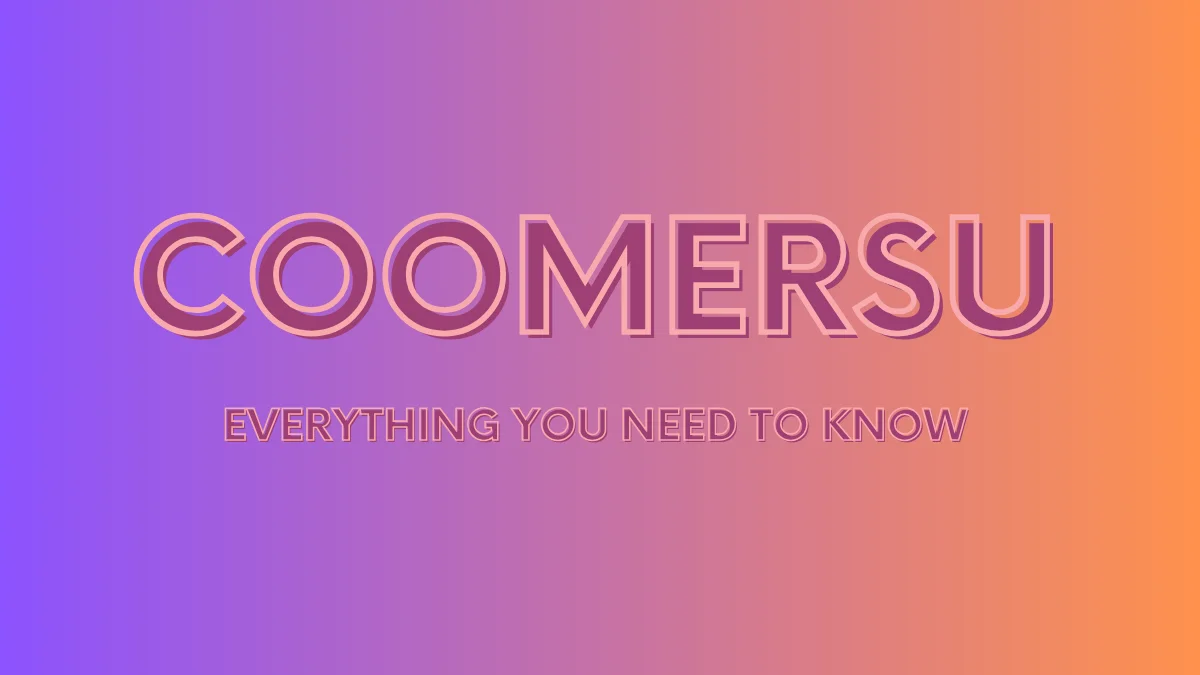In recent years, a new term has emerged in online communities and discussions—coomersu. This term has sparked debates, curiosity, and concern among various groups. As the concept gains traction, it’s important to delve into what coomersu means, its impact, and the cultural implications it carries. This article aims to provide an in-depth exploration of coomersu, shedding light on its origins, manifestations, and societal significance.
Origins of Coomersu
The Evolution of Online Subcultures
The internet has been a breeding ground for diverse subcultures, each with its own unique characteristics and interests. From gaming communities to meme cultures, the online landscape has continuously evolved, giving rise to new terminologies and phenomena. Coomersu is one such term that has gained prominence within certain online circles, particularly those focused on anime, gaming, and related content.
The Emergence of “Coomer” Culture
The term “coomer” originally surfaced as a pejorative label within online forums and imageboards, often used to mock individuals who were perceived as excessively obsessed with adult content, particularly of a sexual nature. Over time, this derogatory term evolved into a broader concept, encompassing not just an obsession with explicit material, but also an all-encompassing fixation on fictional characters, often from anime, video games, or other media. This shift in meaning has led to the emergence of coomersu, a phenomenon characterized by intense emotional investment in fictional characters and their associated narratives.
- Impact on Online Discourse: The proliferation of coomersu has significantly influenced the dynamics of online discourse, shaping the way individuals engage with and consume digital content. Discussions surrounding coomersu often intersect with broader conversations about parasocial relationships, escapism, and the blurred boundaries between reality and fiction.
- Cultural Repercussions: The prevalence of it has raised questions about the impact of hyperfixation on fictional characters and narratives. This phenomenon has prompted discussions about the commodification of fantasy, the ethics of character-based consumption, and the psychological implications of prolonged immersion in virtual worlds.
The Psychological Underpinnings of Coomersu
Coomersu is deeply rooted in psychological and emotional processes that drive individuals to form strong attachments to fictional characters. Understanding the underlying mechanisms can provide valuable insights into the allure of coomersu and its effects on individuals and communities.
Attachment Theory and Parasocial Relationships
At the core of coomersu lies the concept of parasocial relationships, wherein individuals develop one-sided bonds with media personalities, characters, or celebrities. This phenomenon, extensively studied in the field of media psychology, sheds light on the mechanisms through which individuals form emotional connections with fictional entities. These relationships often serve as sources of comfort, companionship, and validation, offering an escape from real-world stressors and challenges.
- Escapism and Emotional Fulfillment: For many individuals immersed in coomersu culture, the appeal lies in the ability to find solace and emotional fulfillment through their connections with fictional characters. These relationships may provide a sense of belonging, understanding, and intimacy that is absent from their real lives.
- Cognitive Dissonance and Identity Formation: The cultivation of parasocial relationships through it can lead to cognitive dissonance as individuals navigate the disjunction between their idealized fantasy world and the complexities of reality. This process may influence self-perception, identity formation, and interpersonal dynamics, blurring the boundaries between the virtual and the tangible.
Manifestations of Coomersu in Popular Media
Impact on Entertainment and Consumer Culture
Coomersu has permeated various facets of popular media, exerting a notable influence on entertainment trends, consumer behavior, and creative industries. Its manifestations are evident in the proliferation of merchandise, fan art, and fanfiction centered around beloved characters, as well as the ways in which media franchises capitalize on the fervent devotion of it enthusiasts.
Merchandising and Fan Communities
One of the most visible expressions of coomersu can be observed in the extensive merchandising and fan-driven economies that have flourished around popular fictional universes. From collectible figurines and apparel to limited-edition artwork, the demand for merchandise featuring beloved characters has created a thriving market catering to coomersu enthusiasts.
- Community Engagement and Creative Expression: Coomersu communities often serve as hubs for creative expression, fostering the production of fan art, fanfiction, and collaborative projects that celebrate and recontextualize cherished characters and narratives. These endeavors contribute to a vibrant ecosystem of user-generated content, enriching the cultural tapestry surrounding fictional worlds.
- Commercial Exploitation and Ethical Considerations: While the commercialization of coomersu-related merchandise fuels economic activity and sustains fan communities, it also raises ethical considerations regarding intellectual property rights, fair compensation for creators, and the commodification of fan labor. Balancing the interests of corporate entities, independent artists, and consumer communities remains a complex challenge in the context of it.
Influence on Narrative Consumption and Interpretation
The prevalence of coomersu has reshaped the ways in which audiences engage with and interpret narratives across various media formats, including anime, video games, literature, and film. This phenomenon has engendered nuanced discussions about the interplay between audience reception, authorial intent, and the subjective construction of meaning within fictional worlds.
Subversion of Canon and Fan-Centric Interpretation
Coomersu culture often leads to the subversion of canonical narratives and character arcs, as fans reinterpret and reimagine established storylines to align with their personal preferences and emotional investments. This practice gives rise to alternative narratives, headcanons, and fan theories that diverge from the original creator’s vision, prompting debates about the legitimacy of fan-driven interpretations.
- Empowerment and Agency: Engaging in coomersu allows individuals to exercise agency in shaping the narratives and identities of their favorite characters, fostering a sense of empowerment and ownership within fan communities. This participatory culture encourages fans to actively contribute to the evolution of fictional worlds, blurring the traditional boundaries between creators and consumers.
- Authorial Intent and Fandom Dynamics: The proliferation of coomersu interpretations raises complex questions about the role of authorial intent, artistic autonomy, and the negotiation of meaning within fan communities. As creators navigate the impact of fan engagement on their works, tensions may arise between preserving narrative integrity and embracing the diverse interpretations fostered by its culture.
Societal Implications and Ethical Considerations
Psychological Well-being and Social Dynamics
The prevalence of coomersu has sparked discussions about its implications for individual well-being, social interactions, and mental health. Examining the psychological underpinnings and social dynamics associated with coomersu sheds light on the multifaceted impact of this phenomenon on individuals and communities.
Emotional Regulation and Coping Mechanisms
For many individuals, coomersu serves as a coping mechanism, providing a source of emotional support, comfort, and distraction from real-world stressors. The immersive nature of parasocial relationships cultivated through coomersu can offer a temporary reprieve from anxiety, loneliness, and existential concerns, albeit with potential long-term implications for emotional regulation and interpersonal relationships.
- Vulnerability and Isolation: The allure of coomersu may be particularly pronounced for individuals experiencing vulnerability, social isolation, or unmet emotional needs. By forging deep connections with fictional characters, individuals may seek solace and validation in virtual spaces, potentially exacerbating feelings of detachment from real-life social networks.
- Therapeutic Potential and Limitations: Exploring the therapeutic potential of it warrants careful consideration, as the phenomenon may offer a form of emotional catharsis and self-expression for some individuals. However, the reliance on parasocial relationships as primary sources of emotional fulfillment raises concerns about the long-term sustainability of such coping mechanisms and their impact on real-world social integration.
Ethical Consumption and Media Literacy
As coomersu continues to shape the landscape of media consumption and fan engagement, ethical considerations surrounding content creation, distribution, and consumption become increasingly pertinent. Navigating the intersection of coomersu culture with media literacy and responsible consumption presents a complex terrain fraught with ethical dilemmas and regulatory challenges.
Representation and Exploitation in Media Content
The portrayal of characters and narratives within coomersu-centric media content raises critical questions about representation, consent, and the potential for exploitation. Balancing the creative freedom of content creators with the ethical imperative to depict characters responsibly and respectfully is paramount in mitigating harm and fostering inclusive storytelling practices.
- Empowerment and Agency: Centering the voices and perspectives of marginalized communities within coomersu content creation empowers creators to challenge stereotypes, amplify underrepresented narratives, and cultivate inclusive environments within fan communities. This emphasis on agency and representation contributes to the diversification of fictional worlds and enriches the cultural fabric of coomersu engagement.
- Consent and Boundaries: Addressing issues of consent and boundaries in the production and consumption of coomersu-related content necessitates a nuanced approach to navigating sensitive themes, power dynamics, and the potential for harm. Establishing clear guidelines for respectful engagement and creative expression within coomersu communities is essential for fostering safe and inclusive environments.
FAQs About Coomersu
What does the term “coomersu” mean?
The term “coomersu” encompasses a broad cultural phenomenon characterized by intense emotional investment in fictional characters and narratives, often originating from anime, video games, and related media. Individuals immersed in coomersu culture form strong parasocial relationships with these characters, seeking emotional fulfillment and escapism through their interactions with virtual personas.
Is coomersu inherently harmful?
While coomersu can provide emotional solace and creative expression for some individuals, it raises complex questions about the impact of prolonged immersion in fictional worlds on mental well-being, social dynamics, and ethical consumption. Careful consideration of the psychological, social, and ethical dimensions of it is essential in evaluating its potential effects on individuals and communities.
How does coomersu intersect with media consumption and fan communities?
Coomersu exerts a significant influence on media consumption patterns, fan-driven content creation, and the commercialization of fictional characters. It shapes the ways in which audiences engage with narratives, interpret canonical works, and participate in creative endeavors within fan communities, contributing to a dynamic ecosystem of user-generated content and cultural exchange.
What are the ethical considerations associated with coomersu culture?
Ethical considerations surrounding coomersu culture encompass issues of representation, consent, and responsible consumption of media content. Balancing the creative freedom of content creators with the imperative to depict characters and narratives responsibly is crucial in fostering inclusive storytelling practices and mitigating potential harm within coomersu communities.
Can coomersu serve as a form of therapeutic engagement?
For some individuals, coomersu may offer a form of emotional catharsis, self-expression, and coping mechanism. However, the reliance on parasocial relationships as primary sources of emotional fulfillment raises concerns about the long-term sustainability of such coping mechanisms and their impact on real-world social integration, warranting careful examination of the therapeutic potential and limitations of coomersu engagement.
Conclusion
The emergence of coomersu as a prominent cultural phenomenon underscores the intricate interplay between media consumption, emotional attachment, and ethical considerations within contemporary digital landscapes. Understanding the origins, manifestations, and societal implications of it is essential in navigating the evolving dynamics of fan engagement, media literacy, and individual well-being. As coomersu continues to shape the cultural fabric of online communities, critical dialogue and ethical reflection remain pivotal in addressing the multifaceted dimensions of this phenomenon.



